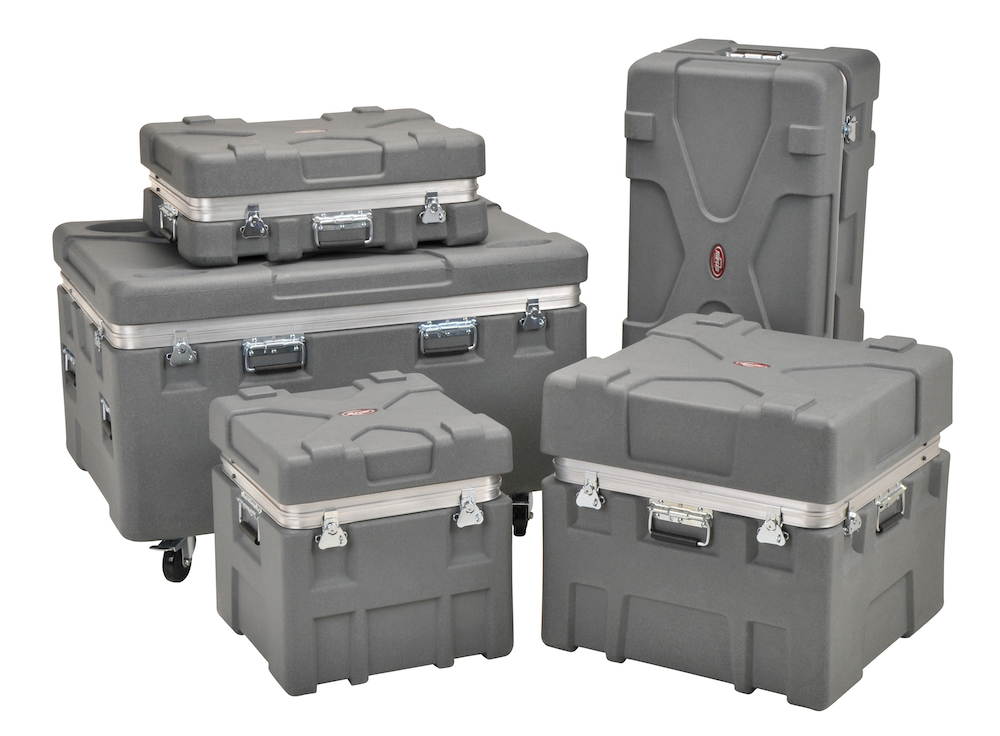Custom cases manufactured by rotational molding yield rugged and lightweight cases. The rotational molding, or rotomolding, process is a highly versatile manufacturing option that allows for unlimited design possibilities at a relatively low production cost. The material of choice for case manufacturing is polyethylene because of its excellent impact and chemical resistant properties.
The Different Stages that Make Up Rotomolding
The rotomolding process is a simple, four-stage cycle.
1. Mold Loading
Rotomolding begins with a quality mold that is placed on an arm of a rotating molding machine that has a loading and unloading area, a heating oven and a cooling station. Several molds may be placed on the machine at the same time. A pre-measured amount of plastic pellet resin is loaded into each mold.
2. Melting
The molds move into the oven where they are slowly rotated on both the vertical and horizontal axis. As heat penetrates the mold, the resin melts and adheres to the mold's inner surface until it is completely fused – no pressure is involved. The simultaneous heating and rotation evenly distributes the material on the inner surface of the mold, maintaining a consistent wall thickness.
3. Cooling
The mold is then cooled by air or water spray or a combination of both while still rotating. This gradually lowers the temperature. Once the parts are cooled, the finished part or case is removed and the mold is ready for the next cycle.
4. Finishing Options
Secondary finishing operations of the routing and riveting of hardware is then completed.
Features and Benefits of Rotomolding
- Economical tooling costs
- Rugged packaging solution – one-piece construction that is virtually stress free
- Lightweight and resilient products
- Excellent load-bearing properties
- Uniform wall thickness
- Variety of finishes and color – molded-in color for reduced maintenance and long-lasting appearance
- Molded-in scratch-proof graphics
- Ability to produce multi-wall moldings, which can be hollow or foam-filled
- Thick corners and ribs for increased impact resistance
- Recessed hardware and molded-in valance extends the useable life of container
- Range of accessories include manual and automatic pressure relief valves, humidity indicators, lifting rings, fork-lift tunnels, removable or retractable or permanently mounted casters, label holders, document pouches, collapsible handles, drawers, brass inserts for panel mount equipment, and racks
- Range of interiors, removable or molded-in, capable of providing total protection
- Dent- and fracture-resistant polyethylene
- Resins can be tailored to suit the application – e.g., to satisfy FDA requirements
- Resistant to most chemicals and solvents
- Resistant to fungus
Rotomolded Case Applications
- Avionic equipment
- Deployable weapons systems
- Electronic testing and monitoring equipment
- Military and law enforcement instrumentation
- Medical testing and apparatus equipment
- Oil field-monitoring equipment
- Portable marine instrumentation
- Portable communications equipment
- Portable computer networks and systems
- Telecommunications test equipment
See If Rotomolding Suits Your Next Project
Rotomolding offers a great solution to produce a rugged shipping container. Rotomolded shipping and storage containers meet the rigorous specifications of the Airline Transportation Association and comply with the ATA 300 Category 1 specification for 100 trip applications. Rotomolded shipping and storage containers can be gasketed to be airtight and watertight. These containers also conform to many military specifications and federal standards.
Once your needs/requirements are determined, Cases By Source can recommend if rotomolding is the right solution for you.








Leave a Comment